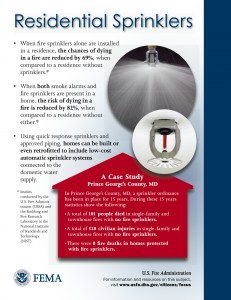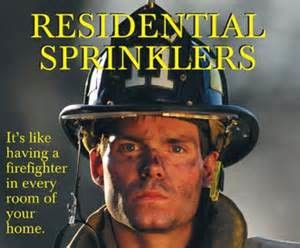By: Robert Avsec, Executive Fire Officer
Increasingly, firefighters are responding to situations where an installed residential sprinkler system has done its job: early activation for quick extinguishment or substantial control of a fire in its incipient stage. These systems are becoming more prevalent in the multi-family dwellings across the United States, but hopefully the fire service will become more successful in getting more of these systems installed in single-family dwellings.
Residential sprinkler systems, unlike their commercial system cousins that are designed to protect property, are designed to provide for life safety by:
- Providing a larger “window of escapability,” more time for occupants to evacuate the dwelling and
- Keeping fire from reaching the point of flashover, thereby protecting firefighters.
As numbers of these systems in the country continue to grow, fire service leaders need to ensure that our fire officers and firefighters have the necessary knowledge, skills and abilities to work with these systems to effectively ensure extinguishment of the fire and effectively address property conservation, the third incident priority.
Most departments emphasize the first two incident priorities, life safety and incident stabilization, much more than property conservation. We remove heat, smoke and standing water following suppression activities, and then we cover window and door openings and return the building to its owner.
The fire service needs to adopt a new paradigm regarding property conservation. The lightweight building materials used in today’s family dwellings are very susceptible to water damage, especially from prolonged water exposure. When the fire occurs on an upper floor, gravity is a powerful force that exposes more interior exposures to water. We need to become more proactive in addressing the third incident priority, especially when sprinkler systems have been activated.
How can we meet this challenge?
We need to focus some of our training and drilling efforts toward developing the salvage-technician skills of our fire officers and firefighters. Most of what we know we learned in entry-level firefighter training, and for many that training was a long time ago. Even for our newer folks, the amount of time allocated to the development of salvage skills is very limited; entry-level training programs tend to focus on development of fire suppression KSAs.
What should our training and drilling focus on? Here a couple of key objectives:
- Learn the location of all the occupancies in your district with residential sprinkler systems installed. Become
 familiar with the location of fire department connections and the control valves for those systems. Here are some Best Practices for Process Instrumentation Lines which you can check out.
familiar with the location of fire department connections and the control valves for those systems. Here are some Best Practices for Process Instrumentation Lines which you can check out. - Share that information with your local dispatch/communications center. The computer-aided dispatch system (CADS) used by those centers today are capable of storing vast amounts of relative information. That information can then link to a particular address when a call is dispatched.
- Be aggressive in assigning responsibility for control of the sprinkler system to a fire officer so that the system can be shut down as soon as fire control is achieved.
- Make an aggressive interior fire attack to get a fire stream to the seat of the fire and ensure complete extinguishment of the fire. Communicate to the incident commander as soon as possible when the system can be shut down. Continue to size-up the fire area for hot spots.
- Make aggressive water removal a key objective of the incident action plan. Tasks should include the use of water vacuum equipment as well as the covering of property and floors below the fire.
- Prompt homeowners and property managers to obtain the services of a professional disaster restoration company as soon as possible. Most of the water-removal equipment that we carry on our apparatus provides a good first step in water removal, but it isn‘t as effective and efficient as the water extraction equipment used by professional disaster restoration companies in minimizing water damage after the fire.
Why do we need to meet this challenge?
As residential sprinkler systems become more commonplace in our communities, we must raise our knowledge and  skills as salvage control technicians to a higher level in our efforts to conserve property following a fire.
skills as salvage control technicians to a higher level in our efforts to conserve property following a fire.
Many people, especially those outside the fire service, believe that residential sprinkler systems cause more damage than the fire because we continue to let the builders and developers control the residential sprinkler agenda. Those same people do not know that sprinkler systems keep the fire from rapidly growing to the point that it can trap occupants or inflict substantial damage on the structure.
By becoming more skilled and practiced in salvage operations at these types of calls, we will have a positive influence on their perceptions. If we can do that, we‘ll increase public support for the installation of residential sprinkler systems in our communities.
Want to know more about residential fire sprinkler systems and how to inform and educate your community and your firefighters about them? Check out the Home Fire Sprinkler Coalition website!
 Fire & EMS Leader Pro The job of old firefighters is to teach young firefighters how to become old firefighters!
Fire & EMS Leader Pro The job of old firefighters is to teach young firefighters how to become old firefighters!